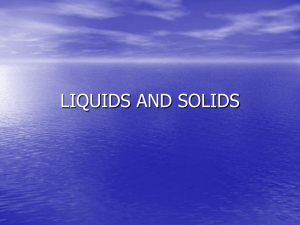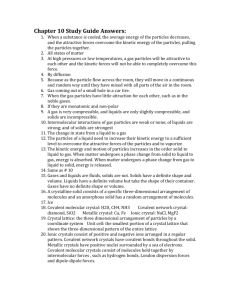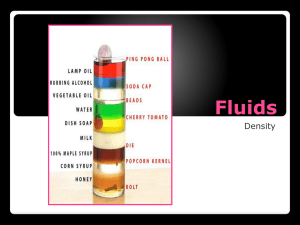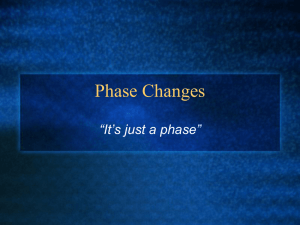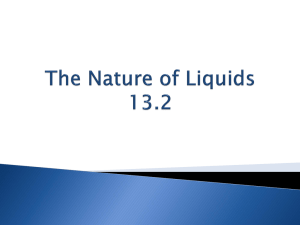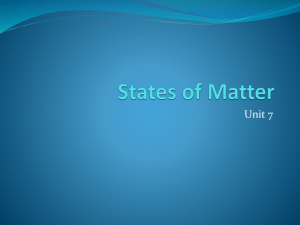Chemistry-notes-ch-12
advertisement
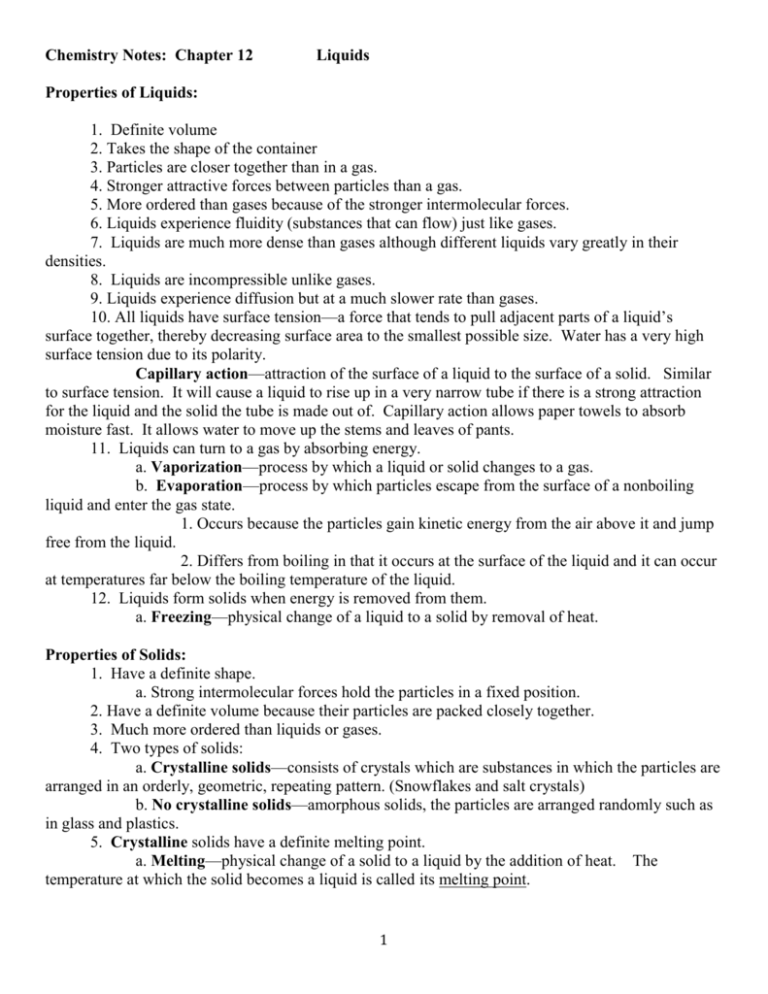
Chemistry Notes: Chapter 12 Liquids Properties of Liquids: 1. Definite volume 2. Takes the shape of the container 3. Particles are closer together than in a gas. 4. Stronger attractive forces between particles than a gas. 5. More ordered than gases because of the stronger intermolecular forces. 6. Liquids experience fluidity (substances that can flow) just like gases. 7. Liquids are much more dense than gases although different liquids vary greatly in their densities. 8. Liquids are incompressible unlike gases. 9. Liquids experience diffusion but at a much slower rate than gases. 10. All liquids have surface tension—a force that tends to pull adjacent parts of a liquid’s surface together, thereby decreasing surface area to the smallest possible size. Water has a very high surface tension due to its polarity. Capillary action—attraction of the surface of a liquid to the surface of a solid. Similar to surface tension. It will cause a liquid to rise up in a very narrow tube if there is a strong attraction for the liquid and the solid the tube is made out of. Capillary action allows paper towels to absorb moisture fast. It allows water to move up the stems and leaves of pants. 11. Liquids can turn to a gas by absorbing energy. a. Vaporization—process by which a liquid or solid changes to a gas. b. Evaporation—process by which particles escape from the surface of a nonboiling liquid and enter the gas state. 1. Occurs because the particles gain kinetic energy from the air above it and jump free from the liquid. 2. Differs from boiling in that it occurs at the surface of the liquid and it can occur at temperatures far below the boiling temperature of the liquid. 12. Liquids form solids when energy is removed from them. a. Freezing—physical change of a liquid to a solid by removal of heat. Properties of Solids: 1. Have a definite shape. a. Strong intermolecular forces hold the particles in a fixed position. 2. Have a definite volume because their particles are packed closely together. 3. Much more ordered than liquids or gases. 4. Two types of solids: a. Crystalline solids—consists of crystals which are substances in which the particles are arranged in an orderly, geometric, repeating pattern. (Snowflakes and salt crystals) b. No crystalline solids—amorphous solids, the particles are arranged randomly such as in glass and plastics. 5. Crystalline solids have a definite melting point. a. Melting—physical change of a solid to a liquid by the addition of heat. The temperature at which the solid becomes a liquid is called its melting point. 1 b. Amorphous solids have no define melting pt. They can flow over a wide range of temperatures. Consequently, they are called supercooled liquids—substances that retain certain liquid properties even at temperatures at which they appear to be a solid. (silly puddy) 6. Solids have high densities being much denser than gases but only slightly denser than liquids. 7. Solids are incompressible. 8. Solids can experience diffusion but at a very low rate. Crystalline solids exist as single crystals or as groups of crystals. The total three-dimensional arrangement of particles of a crystal is called a crystal structure. The smallest portion of this structure is called a unit cell. Many unit cells pack together to make a crystal lattice structure with very distinctive shapes. (p. 369) Crystals can be identified by their shape as above or by the chemical bonding between particles. 1. Ionic crystals--+ and – charged ions arranged in a regular pattern. (Groups 1 & 2 combined with groups 16 and 17 produce these crystals). a. Generally hard and brittle. b. Have high melting points. c. Good insulators. 2. Covalent network crystals—sites contain single atoms each bonded covalently to its nearest neighbors. Diamond is a covalent network crystal. a. Nearly always hard and brittle. b. Rather high melting points. Usually nonconductors or semiconductors. 3. Metallic crystals—consists of metal atoms surrounded by a sea of electrons. a. Good conductors. b. Melting points vary greatly. 4. Covalent molecular crystals—covalently bonded molecules held together by intermolecular forces. (ice crystals) read page 371 a. low melting points b. easily vaporized. c. relatively soft d. good insulators 12-3 Changes of State Equilibrium—dynamic condition in which two opposing changes occur at equal rates in a closed system. Does not occur in an open system. Phase—any part of a system that has uniform composition and properties. Condensation—Process by which a gas changes to a liquid state. In a closed container, the rate of evaporation becomes equal to the rate of condensation. Liguid + heat energy vapor We use a double arrow to show that the reaction is proceeding in both directions. 2 LaChatelier’s Principle—When a system at equilibrium is subjected to a stress, the system will shift in the direction to minimize the stress. In a closed system, for a liquid in equilibrium with its vapor, increasing temperature will favor the forward reaction and the concentration of vapor particles will increase. Decreasing temperature will favor the reverse reaction and the concentration of liquid particles will increase. Table 12-3 Equilibrium Vapor Pressure—the pressure exerted by a vapor in equilibrium with its corresponding liquid at a given temperature. It increases as temperature increases. All substances have distinctive equilibrium vapor pressures. Volatile Liquids—liquids that evaporate easily because of weak attraction forces between particles. The stronger the forces of attraction between particles, the less volatile the liquid. Boiling—conversion of a liquid to a vapor within the liquid as well as at its surface. In an open vessel, boiling occurs when the equilibrium vapor pressure of the liquid equals the atmospheric pressure above the liquid. Consequently, boiling pts change when atmospheric pressure above the liquid changes. THERE IS NO TEMPERATURE CHANGE OF A LIQUID DURING BOILING as all the energy is going to evaporate the liquid. Pressure cookers cook food faster because the water boils at a higher temperature. Also vacuum evaporators are used to boil milk at lower temperatures so it doesn’t scorch. Water boils at 100 degrees C at 1 atm of pressure. Molar Heat of Vaporization—the amount of heat energy needed to vaporize one ole of liquid at its boiling point. It measures the forces of attraction between particles. The stronger the forces, the higher the molar heat of vaporization. Water has a very high heat of vaporization, which makes it a great cooling agent. Freezing pt—temperature at which the solid and liquid are in equilibrium at 1 atm. It is the same temperature as the melting point. Solid + heat energy liquid. Molar heat of fusion—amount of heat energy required to melt one mole of solid at its melting point. Sublimation—process of going from the solid state directly to the gaseous state without passing through the liquid phase. The reverse process is called deposition. Phase Diagram--a graph of pressure versus temperature that shows the condition under which the phases of a substance exist. Figure 12-14 Triple point of a substance—indicates the temperature and pressure conditions at which the solid, liquid, and vapor of the substance can all exist in equilibrium. Critical point of a substance—indicates its critical temperature and critical pressure. Critical Temperature—is the temperature above which the substance cannot exist in the liquid state. Above that temp., the substance cannot exist as a liquid no matter how much pressure is applied. 3 Critical Pressure—lowest pressure at which the substance can exist as a liquid at the critical temperature. 12-14 Water Water consists of two atoms of hydrogen and one atom of oxygen united by a polar covalent bond. It is a bent molecule, which gives it its unique characteristics. The molecules of water are linked with hydrogen bonds. There are usually from 4 to 8 molecules per group in liquid water. However, the number of linked molecules decreases with increasing temperature. If it weren’t for these linked groups, water would be a gas at room temperature. Ice consists of water molecules in a hexagonal arrangement. The empty spaces between the molecules accounts for the relatively low density of ice. As ice melts, water molecules crowd closer together. Water has its maximum density at 3.98 degrees C. At temperatures higher than 3.98 degrees, the increased KE of the molecules cause them to overcome molecular attractions and move farther apart. Physical Properties of water— 1. Transparent 2. Odorless 3. Tasteless 4. Almost colorless 5. At 1 atm., water freezes at 0 C and boils at 100 C. 6. Heat of fusion is 6.009 kJ/mol (higher than most solids) 7. Expands as it freezes therefore; ice is less dense than water. If it weren’t for this property, lakes would freeze over every winter and kill all living things in the water. 8. Heat of vaporization is 40.79 kJ/mol, which is quite high, compared to nonpolar substances of equal mass. It is high because of the strong hydrogen bonding between molecules. (sample problem 12-1) 4

